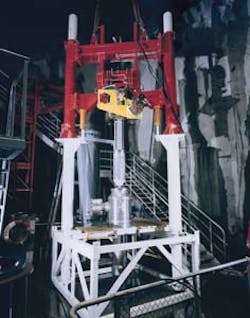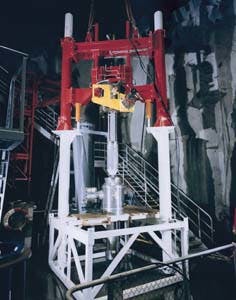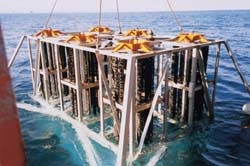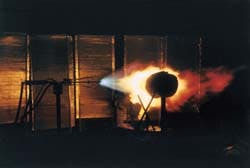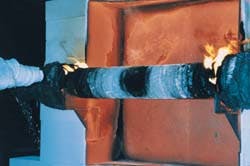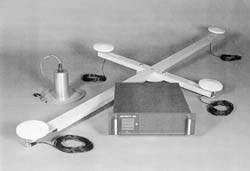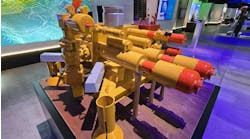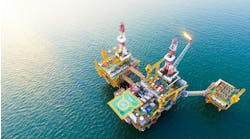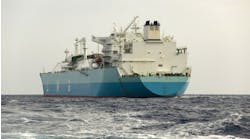East Spar subsea meter designed
for diverless operations
The Framo subsea multiphase flow meter being installed by means of a purpose-built running tool.This spring, Framo Engineering delivered the world's first barrel-insertible subsea multiphase flow meters to Western Mining for the East Spar development in Australia's North West Shelf.
Both meters are designed for diverless running and retrieval. The contract also includes the topside flow computer system and all communication equipment to the field's topside facilities as well as telecommunications services for diagnostic maintenance from Framo's home base in Nesttun, Norway.
Framo followed this breakthrough with contracts for another subsea multiphase flow meter for qualification testing on Statoil's Aasgard development off mid-Norway, and for an initial two meters for BP's North Sea ETAP multi-field project.
Here the meters will be installed on the Monan and Machar Fields in 90 metres water depth, where unprocessed well fluid will be measured before flowing to the central Marnock platform. BP needs subsea metering to optimise production from the fields as no test line or well test facility are available.
The systems selected for East Spar and ETAP both feature a barrel-styled meter with an insert cartridge incorporating all active instruments. The insert is locked into the barrel and equipped with metal seals for full pressure integrity.
The receiver barrel with integrated mixer is permanently installed on the subsea structure and includes no active elements. There are no requirements for straight pipe lengths upstream or downstream the meter. The receiver barrel also serves as the inlet and outlet housing and functions as a guide and support for installation of the insert cartridge.
For ETAP, the subsea interface is in accordance with BP's subsea standardisation initiative specification ST-001. Data transmission to the surface installation is via an RS-422 Modbus RTU link through the production control system pods which during metering will transfer required data once every 60 seconds.
Framo's first subsea prototype multiphase flow meter was manufactured in 1992. Continuous improvements have since been made: according to a paper given by Framo's Birger Velle-Hanssen at last year's North Sea Flow Measurement Workshop, the main improvements in the East Spar system are:
- full metal to metal seal philosophy applied
- insert style gives reduced subsea handling weights
- subsea liquid sampling facilities included
- up to 10,000 psi design available
- diverless running and retrieval, with or without the use of guidewires.
Framo has now sold 19 subsea and topside flow meters to the oil and gas sector. In July, Maersk Olie & Gas ordered a second meter for its Valdemar platform in the Danish sector, following successful operation of the first Framo consignment on the Svend platform.
The technology is also suited to high pressure, high temperature fields. For Texaco's new Erskine development in the UK central North Sea, six Framo multiphase flowmeters are being supplied for the normally unmanned production platform. They are designed for 800 bar (15,000 psi) with a maximum operating temperature of 175?C.
Due to the high pressure rating and the alternative high cost of a manifold, one meter per well was ordered. The six meters will communicate to a common flow computer that processes the measured data for allocation and well testing purposes. The Erskine wells' combined flow rate will be up to 1,200 cu m/hr.
Multiphase principle
The principle of Framo's multiphase flow meter is basically the same for topsides or subsea applications. The system consists of a multi-energy level gamma fraction meter and a Venturi momentum meter in combination with an in-line static mixing unit.
The mixing unit makes the metering system completely independent of upstream flow regimes and provides a homogeneous flow to the metering section. The flow mixer is a purely static device. The most dense part of the fluid is drained from the bottom of the mixer via an ejector, while the lightest fraction is drained from the top and directed via a pipe back to the ejector, where it is mixed with the dense fluid, according to the ejector ratio.
Framo's multi-energy gamma meter determines the fractions of oil, water and gas in the wellstream. It is located immediately downstream the flow mixer, and these fractions can be treated as volume fractions. Calculation of oil, water and gas fractions is based on the relative attenuation of different gamma energy levels. The gamma meter consists of a gamma isotope and a rugged detector.
The combination of two different energy levels is sufficient to determine three fractions, since the third fraction can be deducted by subtracting the first two from 100%.
A Venturi meter is used in combination with the gamma fraction meter to obtain the flow rates of oil, water and gas. This can be done since the Venturi meter is located immediately downstream the flow mixer. Multiphase mixtures have the same properties as single phase mixtures of similar density, and the single-phase Venturi relation can therefore be used. The basic Venturi meter configuration is equipped with high-precision sensors for both Venturi differential pressure and absolute pressure.
Passive acoustic monitoring devices
are sound and flexible performers
ClampOn's range of products includes the ClampOn 2000 Particle Monitor, which has just been joined by the ClampOn 3000 Corrosion and Erosion Monitor. The established ClampOn 1000 Flow Meter is also still available.
All use the principle of passive acoustic monitoring by intelligent ultrasonic sensors of the sound of bubbles and/or particles in gas or liquid flows hitting the pipeline wall. The technology offers a number of benefits, according to Dag Aldal, managing director. The monitoring device is easily installed, being clamped on the outer wall of the pipeline, if necessary removing any external pipe insulation or coating. The device is small - 425mm long by 90mm wide by 140mm high. It can be easily retrieved or relocated, and functions normally in hostile environments. Having no moving parts, it is unlikely to develop defects and is easy to maintain.
Information provided by the monitor, or a number of monitors, is presented in a user-friendly Windows form on a laptop computer. Alternatively the software can be integrated into the main computer system on an offshore platform. The data is transmitted to the computer by digital fibre-optic cable.
Though a young company - its products have been in the market for little more than a year - ClampOn has already supplied the sand monitor to BP in the UK, and to Texaco for its Erskine development; Texaco also bought a number of the company's pig monitors, which use the same principle as the other products.
A number of sand monitors have also been rented out by Total for its Dunbar and Alwyn North Fields, and by Arco for its Thames, Orwell, Gawain, and Welland Fields, and also for its Alaskan operations.
On the Norwegian side, a number of units have been purchased by Saga for the Snorre Field, while Statoil has tested the products and given them a favourable report. It has a technical agreement with Panametrics, which provides the basic sensor technology.
The ClampOn 3000 Corrosion and Erosion Monitor, which is being launched this summer, combines the particle monitor with a Panametrics wall thickness gauge to provide constant information on the flow of particles and the state of the pipe wall.
Worldwide wave data atlas offers
improved accuracy and resolution
Various operators and contractors have shown interest for using remote sensing-based data in the Pacific. Recent practical examples include a study of the spatial variability of the wave climate in Elf Norge's Frigg Field; a study of wave conditions during an ocean two accident, also in Norwegian waters; and a reconstruction of wave conditions during full-scale testing of a tendon for the Heidrun TLP.
These projects were executed by Oceanor, Trondheim which recently introduced its electronic World Wave Atlas (WWA). This is a PC MS-Windows product providing wave and wind data in any region of the global oceans at a spatial resolution and accuracy far better than previously available from global wave compilations derived from visual observations from merchant ships.
"Measurements of significant wave height and wind speed from global satellite altimeter missions is the primary data source for WWA," explains Steve Barstow, oceanographer with Oceanor and responsible for the WWA project.
"The wind and wave measuring satellite altimeter is a vertically pointing pulsed radar designed to measure the range to the ocean surface. The amount of distortion of the returned radar pulse caused by the presence of ocean waves is related to the significant wave height. Wind speed may be derived from the strength of the returned signal which varies with the amount of short wind waves on the surface."
At present, three satellite altimeters are operating globally. These are the US/French Topex/Poseidon mission and the European Space Agency's ERS-1 and ERS-2 satellites.
The World Wave Atlas contains full resolution wave information down to six km along the ground track of the satellite, explains Barstow. The minimum area which can be purchased is a 10-degree latitude/longitude square.
Wave Atlases are being produced for all countries worldwide: recent sales came from Korea and Mexico. Another option is a regional atlas, for example the Far East, Europe, Mediterranean or North America. Prices start from around $3,000 including all data and software, but special prices can be arranged for larger areas or for wave statistics present in report rather than on a PC.
"Clients are usually interested in detailed wave climate statistics for a given location, a country or a shipping route rather than compressed data globally," says Barstow. "Nobody would ever buy the whole WWA, we assume: it would simply be too voluminous."
The WWA is continuously updated and improved. "The next version will include buoy or satellite-validated wave model statistics at locations available and integrated into the altimeter data. Future upgrades of the atlas will incorporate new altimeter data from new missions. We have also been looking at making the atlas more complete with wave direction and period information from the synthetic aperture radar."
Smart buoy
Oceanor also offers a range of advanced oceanographic products, the latest of which was introduced this spring at an oceanology exhibition in the UK. The Smart-800 wave directional buoy system based on GPS technology is manufactured by Seatex which has a patent pending. The buoy was developed in a joint research project funded by Elf Norge, Statoil and the Research Council of Norway.
If placed, for instance, within a range of 20 km from an offshore installation, the buoy will provide data about wave height periods and directions with at least the same accuracy as traditional buoys. According to Oceanor, inter-comparison trials suggest that the GPS buoy is even superior for directional wave measurements.
"In future designs we plan to include tide measurements and current monitoring as well," says sales manager Lars-Inge Graabak. He stresses the handy proportions of the spherically shaped buoy with its diameter of only 0.8 metres and weight of just 20 kg. It also has a durable construction. "As a test, we dropped it from ten metres to the ground without any damage." Five buoys have been sold to date.
Microwave altimeters prove
potential in Ekofisk trials
These radar, as well as the new generation of microwave-based altimeters for use on offshore platforms, demonstrate the increasing significance of remote sensing techniques for the offshore industry.
Systems like these are being developed and marketed by Miros, a small but creative company based near Oslo and dedicated to the application of microwave technology. The new altimeters could conceivably replace conventional laser-based altimeters because electromagnetic microwaves are better able to penetrate water spray. Phillips Petroleum performed a successful test with the radio altimeter on the Ekofisk complex in August 1995, but no versions of the system have yet been sold for use on offshore installations.
The directional wave radar, however, is widely used. "This year we have sold more of these systems than before and we think it is actually becoming quite successful," says Miros' export manager Rolf Joergensen. "Some of the instruments have been in service now for ten years and the only problems encountered are connected to wear and tear of mechanical items. Therefore, we have done away with the rotating parts."
The environmental monitoring systems are being adapted for use on floating systems. Gyro and force-based sensors produce acceleration data for recalculation of the radar data. The wave radar compete with buoys delivering directional wave data.
Troll security
Personnel control systems are another core activity for the company. Uncontrolled locking or unlocking of valves on the Troll gas platform, which came onstream in June, is virtually impossible due to the installation of Miros' electronically monitored key system. Called Intelligent Key Cabinet, the system automatically keeps track of the near-100 valve keys on the platform. Information is transmitted to the central control room over the Troll computer network.
This system is the first of its kind offshore and has been designed and assembled by Miros. The user interface was developed in co-operation with Aker Engineering. The key cabinets have also been installed at the Kollsnes plant onshore where the system controls some 600 keys.
Other systems in Miros' monitoring and tracking ranges include the Miris personnel ID and monitoring system. The wide gate version of this system is capable of tracking three persons passing a gate of 2-2.5 metres. It has been functioning on the Ekofisk complex over the past three years with a detection rate of 99.8%.
Its counterpart, the narrow gate version, allows for a 100% success rate by letting personnel pass one by one. This system has been installed at some airports in southern Norway, but no operator has yet decided to deploy it on an offshore platform. However, these systems could be relevant in cases where a platform has to be evacuated, and where the platform manager needs to locate all personnel without losing time.
Seawater battery feeds subsea well in Adriatic
A seawater battery for use on an autonomous subsea well was installed by Agip in the Adriatic Sea earlier this year.A seawater battery type for powering subsea wells at greater depths has been developed by Simrad Norge and the Norwegian Defense Research Establishment.
Earlier this year a two-year field demonstration project was initiated by Agip at the Luna 27 subsea well in 180 metres water depth in the Adriatic Sea off Italy. An advantage of equipping autonomous wells with seawater batteries is cost reduction, because the umbilical with connectors can be eliminated.
The technology originates from NDRE which developed several systems in the 1980 with Marintek, Statoil and STK. The cells are based on magnesium anodes which use seawater as the electrolyte and oxygen dissolved in the sea water as oxidant. The cathode is fabricated from an inert material such as carbon fibre or copper. Problems such as fouling have been overcome: seawater batteries have been employed successfully in three light buoys off the Norwegian coast since 1989.
However, the cells need a continuous renewal of oxygen-rich sea water. For use in deep water, the design had to be adapted. "We created a very open structure which allowed an almost free flow of water through the battery and installed a large cathode area compared to the cell load," says Simrad's product manager Bent Oystein Johansen. "In addition, we used inert carbon fibre for the cathode which results in a higher voltage." A prototype was successfully tested in a Norwegian fjord at a spot where water circulation is very low.
The power unit consists of a single seawater cell and a DC/DC converter supplying a regulated voltage of 27.6V at 1.2-1.4A. A constantly charged lead-acid buffer accumulator is included for handling peak power demands. During its two years of operation, the system is monitored by means of an acoustic link transferring vital battery parameters to the surface.
Merged lifeboat group delivers package to Samsung for Vietnam
"We are focusing on selling more equipment in the area," says Colin Jarvis who is responsible for offshore marketing within Umoe Schat-Harding. "We expect that some 35% of the total offshore activities worldwide will take place in the Far East during the next three to four years. So for us this is a particularly important market."
Umoe Schat-Harding runs a sales office in Singapore which is staffed by the company's own employees. Dedicated agents are situated in Japan, Korea, China, Taiwan, Malaysia, Indonesia, and Australia. All offshore activities are coordinated and controlled by a project team based in the UK. Other important geographical areas include the North Sea, West Africa, the Gulf of Mexico, and the Arabian Gulf.
The new group is the result of a merger last year between Harding Safety, a subsidiary of the Norwegian maritime group Umoe, and Schat Watercraft in The Netherlands. The merger brought the four brand names Harding, Watercraft, Waterman, and Schat-David Company under the one new title. The group has a lifeboat manufacturing facility in Rosendal, Norway. Subcontractors are based in the UK and Netherlands.
"We pooled our expertise and resources as well as our successful track records," says Jarvis. Clients are promised a one-stop source for cruise tenders, partially enclosed lifeboats, freefall systems, totally enclosed lifeboats, rescue boats, davits and special launching systems. Target markets include cargo shipping as well as the offshore oil and gas sector.
The latter forms only a small part of the group's annual turnover, but is interesting because in this sector, comprehensive, thoroughly engineered packages can be delivered to clients. The group can offer complete design and after-sales support for the full field life including maintenance and service inspections.
As to further product development, Umoe Schat-Harding is involved in research and development programmes which link customers with research institutions and maritime authorities. Some of the group members have been active in the maritime safety sector for more than 60 years.
Unitor eyes Far East shipyards for onboard fire protection
Unitor Ships Service is a subsidiary of the Norwegian company Unitor, a worldwide supplier of marine chemicals, welding equipment, surface preparation equipment, fire protection systems and corrosion protection systems. The offshore sector remains important to the Norwegian company, even though it sold its specialised offshore division last December to a German group.
"The Asian market is significant for us," says Chris Horne of Unitor's Oslo-based marketing department. "It is obviously the fastest growing market nowadays. As a 90% marine oriented supplier we have great interest in major ports such as Singapore and shipbuilding nations such as Korea and Japan." The Norwegian company has sales offices, technical workshops and assembly plants in the Far East and has locations in most shipping nations.
Several new firefighting systems were recently added to Unitor's product range. One is the Hot Foam system, designed for firefighting in enclosed spaces such as engine and pump rooms onboard ships. Systems have already been sold to shipowners, and they would also be suitable for FPSOs, says Horne.
Hot Foam combines the cooling capacity of water with the smoothing properties of foam. The affected area is filled with foam which seals the fire from air supply. The vaporising water absorbs heat energy. An inert atmosphere is created in a very short period during which the fire will be extinguished. Main elements of the system are foam generators and a simple piping system.
Other firefighting systems produced by Unitor include the Fine Water Spray, which can generate a mist or fog of directional water drops through proprietary-design twin fluid nozzles; and the Argonite fire extinguishing system, which is based on a mixture of 50% nitrogen and 50% argon.
Compact camera selected for Aasgard floater
The system, which was approved entry for the ONS Technology Innovation Award last month and will also be presented at OSEA, has won a prestigious first order for Statoil/Saga's Aasgard FPSO off Mid-Norway.
Hernis is a leading supplier of CCTV systems to the offshore industry. Its equipment is installed on nearly all Norwegian platforms, the company claims, while worldwide deliveries have also been made to customers in China, India, Malaysia, Singapore and Vietnam. Far East business is handled through a sales office in Singapore.
The product range includes Ex-certified systems, including Cenelec norms for Zones 1 and 2, and NEC norms for CSA. One of these is a crane CCTV system, certified for Zone 1. All enclosures are made in stainless steel to minimise maintenance and provide a long lifespan.
Keeping abreast of offshore technology developments, Hernis offers custom-designed cameras for production ships and floating storage units, and for submerged turret loading systems.
Easy control of the systems is provided by the Hernis keyboard, which provides the operator with full information on pan and tilt positions and zoom and focus levels. The systems are designed for easy integration with other systems such as fire, smoke, gas and intruder installations.
Insulation system withstands jet fire
at 1,400°C in tests
Crucial to testing the jet fire stop system was the development of a new type of nozzle enabling high enough temperatures and flame velocity to be reached.
The jet fire stop coating survived severe tests on the in-house jet fire rig.Numerous explosions on offshore installations have resulted in jet fires which can develop exceptionally high speeds and temperatures within a short time. Norwegian company Trelleborg Viking recently introduced its own jet fire protection system. But before the product could be developed, a new high temperature, high velocity test site had to be designed and built.
Pool fires can develop temperatures of 900-1,100 °C in 20 minutes, and most offshore platforms have been developed for this situation. Jet fires, however, can reach extreme temperatures up to 1,400 °C and flame velocities of between 80 and 300 metres/sec or even faster within just 20 minutes. The impact or heat flux density of such a fire can range from 300-400kW/sq m.
Until recently there was no known insulator which could protect offshore installations against such impacts. Mjondalen-based Trelleborg Viking, a designer and fabricator of rubber-based insulation and corrosion protection equipment, started development of such protective material in 1992, supported by six Norwegian operators and the KAPOF programme run by the Research Council of Norway.
"We needed a jet fire testing facility which would be able to generate the required temperatures and velocities, which was a very costly affair," explains Kyrre Sjotum, development manager with Trelleborg Viking. "During tests in an existing installation, it appeared that the heat flux density was too hetereogeneously divided over the insulator. We developed a new type of nozzle and used a special mix of gas and oxygen to obtain a more homogeneous flame."
The test facility was developed in co-operation with the Norwegian Technical University NTH in Trondheim. "We now have the most advanced jet flame in the world," says Sjotun. The insulator developed is based on a mixture of natural and artificial rubber, the exact composition of which is kept secret. During tests in the new facility it proved capable of withstanding a flame at a temperature of 1,400 °C, a velocity of 110 metres/sec and heat flux densities of up to 540kW/sq m for up to two hours.
The material's special quality is its capability of sweating when it is heated. The insulation factor even rises and the insulator takes up a substantial amount of energy, thus protecting the material underneath for a certain period. Under tests, a small, but powerful lighter was used to generate a flame of 1,300 °C for a few minutes. Directed at the insulator, no smoke or flame was seen nor any smell released by the material.
Insulation capacity rises in line with the thickness of the insulating layer. A 20mm shield offers one hour protection, 30mm two hours and 40mm three hours of jet fire protection. A side-effect of the jet fire stop is that it also insulates the piping or walls to which it is attached.
Tests by Sintef's Acoustic Research Institute have proven considerable sound isolation capabilities. A fourth advantage is protection against impact from physical force and liquids contacting the surface.
Proserv offers expertise in crude sampling techniques
In 1988 Proserv developed the first mercury-free titanium cylinders. It has also developed a wide range of cylinders in SS316 with different material combinations, including aluminium, titanium, steel and carbon fibre, depending on the customer's requirement.
The company has also undertaken the development of cylinders to be integrated in systems. One example is the Pro-Mix homogenisation system, which is recommended for fiscal metering, allocation and refinery use. The system is available in several models, both portable and stationery, and can be adapted to
individual customers' needs. Pro-Mix is integrated into the sampling side of the total metering activity. Following company policy, the same pressure is maintained in the sampling cylinder as in the transport pipe from which the sample is drawn. Once homogenised, the sample is transferred to a high-pressure syringe which is adapted to a special valve. The contents of the injector are representative of the contents of the cylinder, which in turn is representative of the tanker-load. The same pressure is maintained at all times.
At the laboratory the contents are weighed and injected into Carl Fischer Instruments' titration fluid. "The advantage of this procedure is that we can measure the water content in both the oil and the gas phases," the company says. "Proserv will then have a result which is IP386 superior, and we have proof and
experience of more than +/- 0.1% repeatability."
Together with Saga Petroleum Proserv has also developed a mobile sampling station known as the Pro-Trolley. This is an air-driven system on wheels, which may therefore be used in Ex-zones. "The advantage of the Pro-Trolley is that it is equipped with a timer, adjustable from one to 48 hours, pressure recorder and oil dosing pump, and if necessary, an extractor for gas," the company says. Produced in SS316, the system can be used to take samples during a pre-planned period regardless of the weather. Such a method
gives accurate and reliable samples, the company says.
In the North Sea Proserv has sold Pro-Mix for fiscal sampling at Norske Shell's Draugen platform, and a sampling station and Pro-Mix system to Shell UK. Statoil has bought fiscal metering systems for the Gullfaks A and C platforms, and sampling systems for Troll Gas and Heidrun. Proserv has, moreover, a three-year contract to provide and maintain PVT cylinders on all Statoil's existing and future installations.
In April, the company clinched a Nkr 3 million order to supply sampling equipment to Shell Sarawak in Malaysia. Proserv products are licensed by Petronas in Malaysia.
Seatex tours Australasia to build
on Indonesian references
Seatex's Motion Reference Unit (MRU) has proved a versatile addition to the company's range of products.Seatex, a producer of high-precision measurement instruments for use at sea, is intensifying its marketing in the Far East and Australasia. The company has agents in Japan, Singapore, Taiwan, Australia, and New Zealand, and earlier this year went on a promotional tour of New Zealand, Australia and Singapore.
Based in Trondheim, Seatex was founded in 1984 as a spin-off from IKU, the Continental Shelf Institute. Its main product areas are GPS-based systems, motion sensors and oceanographic buoys. Earlier this year it won an important contract, as a subcontractor to Blom Survey, to establish a comprehensive SATREF differential GPS network system covering Indonesia's vast ocean territory. Seatex's deliveries include Searef DGPS reference stations, which will be connected to the main DGPS control and monitoring centre in Jakarta via a dedicated satellite link, and the Seadiff software for control of the stations.
The Seadiff system is used by offshore survey specialist Fugro on a worldwide basis, and is installed on Golar-Nor's Petrojarl 1 production ship. Other Far East orders include the supply last year of the company's Wavescan oceanographic buoy system to Malaysia's Department of the Environment. Wavescan marketing is now being handled by Oceanor, another Trondheim-based campus company.
One of Seatex's core products is a motion sensor - the Motion Reference Unit (MRU) - specifically developed for marine applications. For the offshore industry the MRU-5 and MRU-6 are the most relevant versions, according to head of systems Vidar Bjoerkedal. Both provide high-precision measurements of roll, pitch and heave motions; the MRU-6 also has a magnetic sensor with magnetic north seeking.
The MRU is small and light, has no moving parts and hence required no scheduled maintenance. It is suitable for a wide variety of applications, Bjoerkedal says, including survey vessel sonars and echo sounders, ROV attitude and heave control systems, heave compensation systems for cranes, dynamic positioning systems, and structure motion monitoring of offshore installations and ships.
Geoteam, part of the Fugro group, has installed an MRU-5 on its survey vessels Geo Surveyor, Geo Scanner and Geo Searcher; they are used for motion compensation of the vessels Simrad multi-beam echosounder systems. Simrad itself is another customer.
A number of additional MRU-5 units have been acquired by Subsea Offshore in Aberdeen, which first used it last year, for survey work. Singapore-based Ashtead Technology, a rental company, has also taken delivery of a unit.
Seatex has developed other systems incorporating the MRU. One of these is Seapath, a high-precision heading, attitude and position sensor for the professional survey market. Seapath brings together DGPS carrier phase measurements and MRU motion data to provide robust heading and attitude calculations to an accuracy of 0.05 degrees.
Seapath also provides accurate roll and pitch measurements to the same degree of accuracy, position measurement to within one metre, and velocity to within 0.03 metres/sec. Motion data with a high update rate is used to monitor the GPS observations, which in turn are used to calibrate the motion data, thus achieving mutual integrity monitoring not found in any single sensor system. "In the future we see this kind of technology replacing standard navigational gyro systems," says Bjoerkedal. "Unlike existing systems, Seapath has no moving parts and does not need calibration. For the same reason its life-cycle costs will be much lower."
The Seapath 400, the latest version, was installed by Western Geophysical on the Western Monarch seismic survey vessel as part of a major upgrade completed this summer. It is also to be installed on Norsk Hydro's Njord Field, both on the semisubmersible production platform and on the ship-shaped floating storage unit. Altogether more than a dozen units have already been sold, though the system was launched less than a year ago. The MRU has also been combined with meteorological sensors to produce the Seatex Helideck Monitoring System. This gives the helicopter pilot real-time information on the deck motion of the ship or platform which he is approaching, as well as the current meteorological parameters, thus improving safety during landing. As it monitors the ship's dynamic motion, the HMS also provides information on the dynamic forces which will be transferred to the helicopter on landing, thus enabling the pilot to check that these are within the craft's capability.
The system has been installed on PGS's new seismic vessels, the Ramform Explorer and the Ramform Challenger. It has also proved popular in the defence sector - Seatex recently won a contract against stiff international competition to provide it to Canada's Bombardier defence company. It has been sold to the French and British navies, and is being tested by the US Navy.
Seatex is also a pioneer of the use of laser imaging and surveying systems for seabed mapping and remote subsea operations. Having completed a four-year R&D programme, it has now launched Spotmap, the first underwater laser imaging system. Using the laser radar concept, Spotmap provides video quality 3D imaging at distances four to five times greater than conventional TV and photographic systems.
Spotmap was developed with support from Amoco Norway and a prototype was used last year to assist with the installation of the Troll oil pipeline across the steeply sloping terrain of the Norwegian Trench. Support is currently being provided through an industrialisation contract with Statoil, a potential future customer.
Copyright 1996 Offshore. All Rights Reserved.
